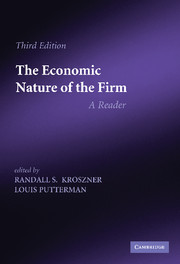Book contents
- Frontmatter
- Contents
- Editors' preface
- Reintroducing The Economic Nature of the Firm
- Part I Within and among firms: the division of labor
- Part II The scope of the firm
- 7 The nature of the firm
- 8 Vertical integration, appropriable rents, and the competitive contracting process
- 9 The governance of contractual relations
- 10 The limits of firms: incentive and bureaucratic features
- 11 Bargaining costs, influence costs, and the organization of economic activity
- 12 The boundaries of the firm revisited
- Part III The employment relation, the human factor, and internal organization
- Part IV Finance and the control of the firm
- References
- References
12 - The boundaries of the firm revisited
Published online by Cambridge University Press: 05 June 2014
- Frontmatter
- Contents
- Editors' preface
- Reintroducing The Economic Nature of the Firm
- Part I Within and among firms: the division of labor
- Part II The scope of the firm
- 7 The nature of the firm
- 8 Vertical integration, appropriable rents, and the competitive contracting process
- 9 The governance of contractual relations
- 10 The limits of firms: incentive and bureaucratic features
- 11 Bargaining costs, influence costs, and the organization of economic activity
- 12 The boundaries of the firm revisited
- Part III The employment relation, the human factor, and internal organization
- Part IV Finance and the control of the firm
- References
- References
Summary
Why do firms exist? What is their function, and what determines their scope? These remain the central questions in the economics of organization. They are also central questions for business executives and corporate strategists. The worldwide volume of corporate mergers and acquisitions exceeded $1.6 trillion in 1997. It is hard to imagine that so much time, effort and investment bankers' fees would be spent on adjusting firm boundaries unless there was some underlying economic gain. Indeed, the exceptional levels of merger and acquisition activity over the past two decades are a strong indication that economically significant forces do determine organizational boundaries.
The study of firm boundaries originated with the famous essay by Coase (1937), who raised the question of why we observe so much economic activity inside formal organizations if, as economists commonly argue, markets are such powerful and effective mechanisms for allocating scarce resources. Coase's answer was in terms of the costs of transacting in a world of imperfect information. When the transaction costs of market exchange are high, it may be less costly to coordinate production through a formal organization than through a market.
In large part thanks to the work of Williamson (1975, 1985), recent decades have seen a resurgence of interest in Coase's fundamental insight that firm boundaries can be explained by efficiency considerations. Our understanding of firm boundaries has been sharpened by identifying more precisely the nature and sources of transaction costs in different circumstances.
- Type
- Chapter
- Information
- The Economic Nature of the FirmA Reader, pp. 156 - 170Publisher: Cambridge University PressPrint publication year: 2009



